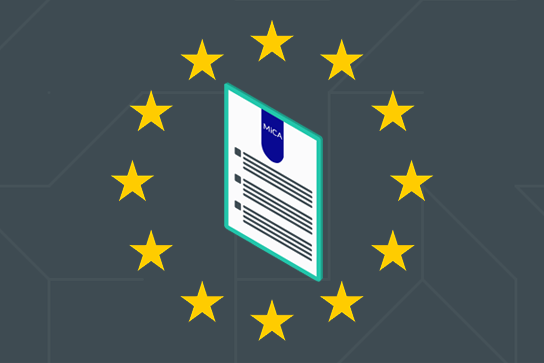
The Markets in Crypto Assets Regulation (MiCA) Tackled
Below we answer some of the most popular questions about REGULATION (EU) 2023/1114 OF THE EUROPEAN PARLIAMENT AND OF THE COUNCIL of 31 May 2023 on markets in crypto-assets, and amending Regulations (EU) No 1093/2010 and (EU) No 1095/2010 and Directives 2013/36/EU and (EU) 2019/1937 (referred to as MiCA going forward) and provide the sources.
Are MiCA and the TFR the Same?
No, they are not the same, but they do work hand-in-hand. The Markert in Crypto Assets Regulation (MiCA) is a regulatory framework proposed by the European Commission to regulate crypto assets within the EU.
Unlike the FATF’s Recommendations and the Transfer of Funds Regulation (TFR), MiCA does not tackle anti-money laundering (AML) risks. It was designed to align EU legislation with the FATF’s Recommendations, which includes the terminology and scope of the regulations to a certain degree.
Furthermore, MiCA regulates centralised entities such as CASPs and stablecoin issuers. It is part of the comprehensive EU Digital Finance framework and references several other regulatory frameworks, including:
The Transfer of Funds Regulation (TFR)
The AML Package (AMLR, AMLD6, and AMLA)
The Markets in Financial Instruments Directive (MiFID II)
The E-money Directive
Read Does MiCA Impact Crypto Asset Service Providers (CASPs)? for further clarification on the differences between MiCA and the TFR.
What Is MiCA’s Scope?
MiCA applies to natural and legal persons who issue, offer, and trade crypto assets or provide services related to crypto assets within the EU.
A crypto asset service includes a service or activity that involves the following:
“providing custody and administration of crypto-assets on behalf of clients;
operation of a trading platform for crypto-assets;
exchange of crypto-assets for funds;
exchange of crypto-assets for other crypto-assets;
execution of orders for crypto-assets on behalf of clients;
placing of crypto-assets;
reception and transmission of orders for crypto-assets on behalf of clients;
providing advice on crypto-assets;
providing portfolio management on crypto-assets;
providing transfer services for crypto-assets on behalf of clients.”
See Article 2: Scope, for further information.
MiCA Does Not Cover the Following:
MiCA only regulates centralised entities; therefore, it does not cover DeFIs and DAOs (provided the organisation or protocol is 100% decentralised).
It does not cover NFTs if they meet the prerequisite of being “unique and not fungible with other crypto assets” or the lending and borrowing of crypto assets.
This is a non-exhaustive list; for a complete description, refer to Article 2: Scope, points 2 - 4 or read What Is The Markets in Crypto Assets (MiCA) Regulation?
Is a VASP a CASP?
Yes and no. A virtual asset service provider (VASP) and a crypto asset service provider (CASP) are very similar in function except for two differences: the FATF’s definition of a VASP is not as explicit as MiCA’s CASP, nor does it extend to cover crypto advisory services.
MiCA defines a CASP as “any person whose occupation or business is the provision of one or more crypto-asset services - as mentioned above - to third parties on a professional basis.”
The FATF defines a VASP as “any natural or legal person who is not covered elsewhere under the Recommendations, and as a business conducts one or more of the following activities (stated below) or operations for or on behalf of another natural or legal person.”
“The exchange between virtual assets and fiat currencies,
The exchange between one or more forms of virtual assets,
The transfer of virtual assets,
The safekeeping and/or administration of virtual assets or instruments enabling control over virtual assets
The participation in and provision of financial services related to an issuer’s offer and/or sale of a virtual asset.”
See Article 3 Definitions and read Is A VASP a CASP? for further information on the topic.
Does the EU Still Use Stablecoins?
Yes and no. Per MiCA’s Consideration 8, stablecoins were redefined to be more specific and future-proof. What once were stablecoins are now known as Asset-referenced Tokens (ARTs) and Electronic Money Tokens (EMTs). Under MiCA’s framework, the terms stablecoin and Asset-backed Token (ABT) will have no legal meaning in the EU as they fall under different frameworks.
MiCA defines an ART as “a type of crypto-asset that is not an electronic money token, and that purports to maintain a stable value by referencing another value or right or a combination thereof, including one or more official currencies.”
And an EMT as “a type of crypto-asset that purports to maintain a stable value by referencing the value of one official currency.”
Read The Ultimate Guide to MiCA's Asset-referenced Tokens and The Ultimate Guide to MiCA's Electronic Money Tokens (EMTS) for summaries of MiCA Titles III and IV.
MiCA’s ART Expectations
ARTs referencing EU currencies will have no usage limits, whereas ARTs pegged to non-EU currencies will be capped at EUR 200 million.
With the implementation of the MiCA framework, ART issuers and providers will be subject to additional obligations, including:
All ARTs will be supervised by the European Securities and Markets Authority (ESMA) unless they are deemed “significant,” in which case the European Banking Authority (EBA) will assume supervision.
Only token issuers with a registered office in the EU will be allowed to issue ARTs. This registration requires proper supervision and monitoring of public ART offerings.
ARTs not pegged to a European currency will be regulated to maintain the EU’s monetary dominance.
Read Stablecoins Are No More: MiCA’s EMTs and ARTs Explained to find out what it means for an ART to be significant.
MiCA’s EMT Expectations
According to MiCA, EMTs must be backed by real-world assets. For instance, if an issuer releases EUR 100,000 of a Euro-pegged EMT, they must hold EUR 100,000 (or assets denominated in EUR) in reserve, such as in a vault or bank account.
Like electronic money, which maintains a one-to-one equivalence, EMTs function similarly but are based on distributed ledger technology.
EMTs that reference EU currencies will have no usage limits, whereas EMTs pegged to non-EU currencies will have their usage capped at EUR 1 million.
Read Stablecoins Are No More: MiCA’s EMTs and ARTs Explained for further clarification and examples.
What’s the Difference between ARTs and EMTs?
An ART can be pegged to more than 1 fiat, physical asset, cryptocurrency, or a mixture of all three, as seen with PAX Gold or DIAM.
The most significant difference between an ART and an EMT is that EMTs can only be pegged to one fiat currency, for example, Tether or USDC.
Read Stablecoins Are No More: MiCA’s EMTs and ARTs Explained for more information.
Does MiCA Impact CASPs?
Yes, it does. CASPs providing their services within the EU are subject to the MiCA regulation. MiCA is a list of regulatory standards CASPs operating in the EU must implement.
With MiCA, CASPs must fulfil certain checks before they are legally allowed to operate within the EU.
See Title V Authorisation And Operating Conditions For Crypto-Asset Service Providers for further details. Topics discussed include permitted services, how to apply for authorisation obligations of CASPs and more.
Does MiCA Impact Non-European CASPs?
Yes, it does. MiCA is a European framework that applies to all entities offering crypto assets or services within Europe. For a foreign CASP to provide services within Europe, it will need to be established in the EU to obtain the relevant authorisation and comply with MiCA regulation.
Non-European CASPs (foreign CASPs) must comply with MiCA regulations to offer their services within the EU. This includes obtaining authorisation from relevant EU authorities and adhering to MiCA’s standards, including consumer protection, transparency, operational resilience, and anti-market abuse measures.
Moreover, foreign CASPs must establish a legal presence in the EU, such as a registered office, to apply for authorisation and operate under MiCA, which involves meeting specific requirements and undergoing supervision by EU regulators.
If foreign CASPs issue “stablecoins”, they must meet MiCA’s specific requirements for stablecoin issuers, such as maintaining adequate reserves and adhering to caps on non-EU currency-pegged stablecoin.
See Does MiCA Impact Crypto Asset Service Providers (CASPs)? for additional clarification.
Do you have a question that wasn’t addressed in the article? Let us know.



